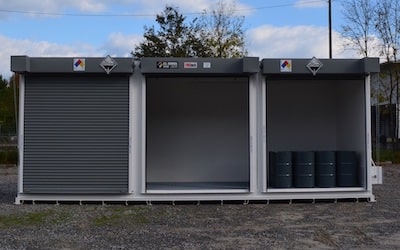Keep the Flames Out of Flammables

What is the difference between flammable and combustible liquids and does this affect storage?
There are two main codes that define categories of flammable and combustible storage materials and they differ slightly from each other. It is important to know the specific compliance requirements for your application and location. Expert advice on fire rated, flammable and combustible storage options can help your company stay compliant and avoid fines and penalties. Both OSHA and the fire codes define flammable liquids by their flash point. Only the NFPA 30 – Flammable and Combustible Liquids Code, NFPA 1 – Fire Code, and IFC – International Fire Codes differentiate a flammable liquid vs. a combustible liquid. A flammable liquid is any liquid with a flash point less than 100°F and a combustible liquid is any liquid that has a flash point at or above 100°F.OSHA classifications
OSHA 1910.106 per GHS no longer defines combustible liquids but defines all liquid with a flashpoint at or less than 199.4°F as a flammable liquid. The OSHA standard breaks down the classifications of flammable liquids as follows:Under OSHA’s standard 29 CFR 1910.106, a flammable liquid is defined as any liquid having a flashpoint at or below 199.4°F (93°C). This definition aligns with the Globally Harmonized System of Classification and Labeling of Chemicals (GHS). The standard classifies flammable liquids into four categories based on their flashpoints and boiling points:
Category 1: Liquids with flashpoints below 73.4°F (23°C) and boiling points at or below 95°F (35°C).
Category 2: Liquids with flashpoints below 73.4°F (23°C) and boiling points above 95°F (35°C).
Category 3: Liquids with flashpoints at or above 73.4°F (23°C) and at or below 140°F (60°C). When a Category 3 liquid with a flashpoint at or above 100°F (37.8°C) is heated for use to within 30°F (16.7°C) of its flashpoint, it must be handled in accordance with the requirements for a Category 3 liquid with a flashpoint below 100°F (37.8°C).
Category 4: Liquids with flashpoints above 140°F (60°C) and at or below 199.4°F (93°C). When a Category 4 flammable liquid is heated for use to within 30°F (16.7°C) of its flashpoint, it must be handled in accordance with the requirements for a Category 3 liquid with a flashpoint at or above 100°F (37.8°C).
These classifications are detailed in OSHA’s regulation 29 CFR 1910.106(a)(19).
NFPA classifications
The National Fire Protection Association (NFPA) classifies liquids based on their flash points and boiling points into flammable and combustible categories. Class I liquids are considered flammable, while Class II and Class III liquids are deemed combustible. The breakdown is as follows:
Flammable Liquids (Class I):
Class I-A: Liquids with flash points below 73°F (23°C) and boiling points below 100°F (38°C). Examples include diethyl ether and pentane.
Class I-B: Liquids with flash points below 73°F (23°C) and boiling points at or above 100°F (38°C). Examples include acetone and ethanol.
Class I-C: Liquids with flash points at or above 73°F (23°C) and below 100°F (38°C). An example is p-xylene.
Combustible Liquids:
Class II: Liquids with flash points at or above 100°F (38°C) and below 140°F (60°C). Examples include diesel fuel and kerosene.
Class III-A: Liquids with flash points at or above 140°F (60°C) and below 200°F (93°C). Examples include linseed oil and mineral oil.
Class III-B: Liquids with flash points at or above 200°F (93°C). An example is glycerol.
These classifications are detailed in NFPA 30: Flammable and Combustible Liquids Code.
Storage for flammable and combustible materials
As can be seen from the paint and body shop incident above, the purpose of safe storage practices for flammable and combustible liquids is to keep them away from potential sources of ignition. Regulations also determine the maximum quantities of the different class materials, which may be kept in close proximity to or inside occupied buildings. U.S. Chemical Storage supplies storage lockers which are built with heavy gauge steel and can be selected with a 2-hour or 4-hour fire rating. 2-hour fire-rated FireLoc chemical storage lockers are designed for flammable and combustible storage of materials between 10 and 30 feet from occupied buildings. 4-hour fire-rated SUPERloc chemical storage lockers can safely house these materials within 10 feet of an occupied building, or even inside another building.List of standards for flammable and combustible storage materials
- 29 CFR OSHA 1910.106 – Flammable Liquids
- NFPA 30 – Flammable and Combustible Liquids Code
Contact us
Contact U.S. Chemical Storage to learn more about flammable and combustible storage for dangerous materials or to receive a complimentary quote. Our professional consultants can advise you on the best flammable storage solution for your application as well as the regulatory requirements that are relevant to your industry.References
- UC San Diego. Flammable and combustible liquids overview
